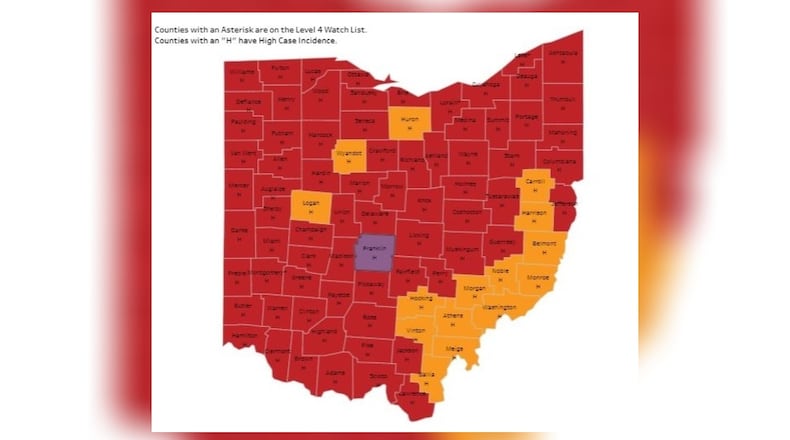The state’s advisory system ranges from level 1, or yellow as lowest to level 4 or purple as highest and most severe.
The Ohio Department of Health uses seven indicators when judging what level to give a county.
Indicators hit include new cases per capita, sustained increase in new cases, proportion of cases not in a congregate spread, sustained increase in emergency department visits for COVID-like illness, sustained increase in outpatient visits for COVID-like illness, sustained increase in new COVID hospital admissions and ICU bed occupancy.
This week the county hit four indicators: new cases per capita, sustained increase in new cases, proportion of cases not in a congregate spread, sustained increase in outpatient visits for COVID-like illness.
This week, Champaign County hit four indicators: new cases per capita, sustained increase in new cases and proportion of cases not in a congregate spread and sustained increase in outpatient visits for COVID-like outpatient visits.
Franklin County became the first Level 4, or purple, county on Thursday while Montgomery County made the level 4 watch for the first time.
Purple counties meet at least six data indicators for at least two consecutive weeks. Counties on the watch list meet at least six indicators but have not done so for two consecutive weeks.
Clark County had a total of 4,499 cases, 110 deaths and five probable deaths of the coronavirus as of Thursday, according to the Ohio Department of Health. Champaign County had a total of 817 cases, three deaths and one probable death.
However, case data for Thursday is incomplete due to “thousands of reports pending review,” according to ODH’s website.
Virus data was posted several hours later than the usual 2 p.m. update on Wednesday. Gov. Mike DeWine said on Thursday the reason the data was late, and why thousands of cases are being reviewed, is because the state is “double-checking” all antigen test results.
The state double-checks the results of all antigen tests before adding the results to the state’s data. But with the recent increases in antigen testing, the state is starting to fall behind on confirming those results.
“Our data team tells us there are 12,000 antigen tests that have not yet been double-checked,” DeWine said. “Most of the 12,000 are expected to be confirmed.”
On average, Ohio is running 10,000 antigen tests a day, DeWine said.
Ohio reported 7,787 cases and 63 deaths of coronavirus between Wednesday and Thursday, according to ODH. In total, the state reported 326,615 cases and 5,890 deaths of the virus on Thursday.
The state has a total of 23,560 hospitalizations since the pandemic began in March, with 343 reported Thursday. There are 3,829 COVID-19 patients in Ohio hospitals Thursday, with 976 in southwest Ohio, according to ODH.
A new statewide curfew took effect Thursday night. Under it, Ohioans are advised to stay home from 10 p.m. to 5 a.m. Exemptions include people going to and from work, seeking medical care or getting groceries or takeout.
“If you can stay home, stay home,” DeWine said. “This is very, very serious. We have to take this down.”
About the Author

